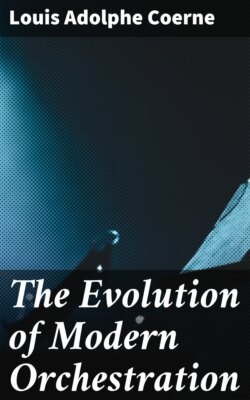Читать книгу The Evolution of Modern Orchestration - Louis Adolphe Coerne - Страница 24
IV.
ОглавлениеAs intimated above, further survey of the field of instrumentation in Italy discovers commendable activity, such as was displayed by Legrenzi; by Steffani and Clari; by the violinists Torelli, Vivaldi, and especially Corelli; finally, by the greatest musician both active and creative of the seventeenth century, Scarlatti.
The labors of Legrenzi (1625) are worthy of consideration on account of his logical development of the constituency of the orchestra. As Maestro at San Marco, Venice, he increased the number of instrumentalists at that church to over thirty. It is noteworthy that he employed almost exclusively violins and viols, supported in the bass by four theorbos (i.e. bass instruments of the lute family). The wood-wind was represented by a solitary bassoon, whereas two cornets and three trombones replaced Monteverde's earlier assortment of brass. And thus, already in the seventeenth century was found a man whose perspicuity in the choice of a modest band of loud-voiced instruments commended itself for some of the mightiest climaxes of Beethoven's immortal works.
The significance of chamber music as fostered by Steffani (1655) and Clari (1669) is, of course, well known in musical history. And the wonderful impetus given to the art of violin-making, by stimulating a development of executive technique, brought forth fruit that culminated in the regency of a number of famous violinist-composers. Among these, Torelli (died 1708), for the creation of the concerto grosso, Vivaldi (died 1743), for the development of harmonic design and figuration characteristic of his instrument, and Corelli (1653-1713), for combining principles of harmony with contrapuntal devices, rendered invaluable service to the nascent architecture of modern string writing. For by exploring the possibilities of the violin, by establishing its superiority as a solo instrument, by demonstrating not only its potentiality but also its limitations in relation to other instruments, there arose, in consequence, a more delicate perception as to the necessary constitution of an evenly balanced string band. This acquirement was accompanied by improved methods of writing for the strings.
No composer of his time combined these requirements more successfully than Corelli, for the types of composition which occupied his attention were the precursors of the classic sonata, and his contributions thereto mark the starting point of genuinely artistic instrumental music. Corelli's relation to chamber music and the concerto is as that of Monteverde to the orchestra. Neither of them was a radical reformer; they both proceeded along the more conservative lines of evolution, selection, elaboration. The scaffolding of their respective spheres of activity had already been reared by that countless throng of forgotten and unappreciated workers, whose mission it is to make smooth the path for the greater lights, that appropriate and mould into collectaneous form the puny though individual originality of the lesser. But whereas nothing more than a pious interest in an historic heirloom has preserved Monteverde's efforts from falling into oblivion, those of Corelli have been perpetuated by reason of their intrinsic merit.
